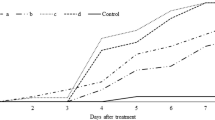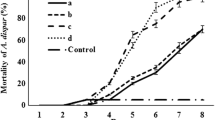Abstract
During a survey for natural enemies of the rosaceous longhorn beetle (RLHB), Osphranteria coerulescens, two isolates of entomopathogenic fungi (EPF) were found in Razavi Khorasan province of Iran. These isolates were determined to be of the species Beauveria bassiana and Metarhizium anisopliae using morphological characteristics and molecular analysis. Subsequently, the mycosis process of the isolates on larvae of RLHB was documented using scanning electron microscopy (SEM). In order to assess virulence of these indigenous isolates of EPF, a series of trials were conducted against RLHB larvae, pupae and adult stages. In laboratory bioassays the pest was susceptible to both EPF isolates, but the B. bassiana isolate caused significantly higher mortality than the M. anisopliae isolate in all life stages tested. In a semi-field trial EPF suspension containing 2.5 × 1010 viable conidia per ml was sprayed directly against pest larvae beneath tree bark under two conditions: apricot branches covered with a polyvinyl cover and without cover. The B. bassiana isolate showed a higher infection rate than M. anisopliae and the cover had significant effect on larval mortality, ranging from 67 % for covered infested apricot branches to 31 % without cover in the B. bassiana treatments. Our findings revealed that polyvinyl covers were necessary to improve conidial persistence under field conditions. In a supplementary survey on the semi-mass production potential of the fungal conidia, the ability of B. bassiana and M. anisopliae to germinate was studied using three solid media. Sugar beet pulp provided the highest yield of conidia for both EPF species, and can be considered as an effective solid medium for fungal growth. These findings highlighted the potential of EPFs as biocontrol agents of O. coerulescens.




Similar content being viewed by others
References
Abbott WS (1925) A method of computing the effectiveness of an insecticide. J Econ Entomol 18:265–267
Behdad E (1984) Pests of fruit trees in Iran. Neshat press, Isfahan
Bidochka MJ, Kasperski JE, Wild GA (1998) Occurrence of the entomopathogenic fungi Metarhizium anisopliae and Beauveria bassiana in soils from temperate and near-northern habitats. Can J Bot 76:1198–1204
Campos RA, Arruda W, Boldo JT, de Silva MV, de Barros NM, de Azevedo JL, Schrank A, Vainstein MH (2005) Boophilus microplus Infection by Beauveria amorpha and Beauveria bassiana: SEM analysis and regulation of subtilisin-like proteases and chitinases. Curr Microbiol 50:257–261
Carrillo D, Dunlap CA, Avery PB, Navarrete J, Duncan RE, Jackson MA, Behle RW, Cave RD, Crane J, Rooney AP, Pena JE (2015) Entomopathogenic fungi as biological control agents for the vector of the laurel wilt disease, the redbay ambrosia beetle, Xyleborus glabratus (Coleoptera: Curculionidae). Biol Control 81:44–50
Castrillo LA, Ugine TA, Filotas MJ, Sanderson JP, Vandenberg JD, Wraight SP (2008) Molecular characterization and comparative virulence of Beauveria bassiana isolates (Ascomycota: hypocreales) associated with the greenhouse shorefly, Scatella tenuicosta (Diptera: Ephydrididae). Biol Control 45:154–162
Dorta B, Bosch A, Arcas JA, Ertola RJ (1990) High level of sporulation of Metarhizium anisopliae in a medium containing by-products. Appl Microbiol Biotech 33:712–715
Dubois T, Lund J, Bauer LS, Hajek AE (2008) Virulence of entomopathogenic hypocrealean fungi infecting Anoplophora glabripennis. BioControl 53:517–528
Esmaeili M (1983) Important pests of fruit trees. Sepehr Publishing Center, Tehran
Glare TR, Placet C, Nelson TL, Reay SD (2002) Potential of Beauveria and Metarhizium ascontrol agents of pinhole borers (Platypus spp.). N Z Plant Protect 55:73–79
Güerri-Agullo B, Gumez-Vidal S, Asensio L, Barranco P, Lopez-Lorica LV (2010) Infection of the red palm weevil (Rhynchophorus ferrugineus) by the entomopathogenic fungus Beauveria bassiana: a SEM study. Microsc Res Tech 73:714–725
Hajek AE, Bauer LS (2007) Microbial control of wood-boring insects attacking forest and shade trees. In: Lacey LA, Kaya HK (eds) Field manual of techniques in invertebrate pathology. Springer, Secaucus, pp 505–525
Hajek AE, Huang B, Dubois T, Smith MT, Li Z (2006) Field studies of control of Anoplophora glabripennis (Coleoptera: Cerambycidae) using fiber bands containing the entomopathogenic fungi Metarhizium anisopliae and Beauveria brongniartii. Biocontrol Sci Technol 16:329–343
Humber RA (2012) Identification of entomopathogenic fungi. In: Lacey LA (ed) Manual of techniques in invertebrate pathology. Academic Press, Amsterdam, pp 151–186
Jenkins NE, Prior C (1993) Growth and formation of true conidia by Metarhizium flavoviride in a simple liquid medium. Mycol Res 97:1489–1494
Jenkins NE, Heviefo G, Langewald J, Cherry AJ, Lomer CJ (1998) Development of mass production technology for aerial conidia for use as mycopesticides. Biocontrol News Inform 19:21–31
Kim JJ, Kim KC (2008) Selection of a highly virulent isolate of Lecanicillium attenuatum against cotton aphid. J Asia-Pacific Entomol 11:1–4
Kumar CS, Jacob TK, Devasahayam S, D’Silva S, Kumar NK (2015) Isolation and characterization of a Lecanicillium psalliotae isolate infecting cardamom thrips (Sciothrips cardamomi) in India. BioControl 60:263–373
Lacey LA, Grzywacz D, Shapiro-Ilan DI, Frutos RM, Brownbridge M, Goettel MS (2015) Insect pathogens as biological control agents: back to the future. J Invertebr Pathol 132:1–41
Lee SJ, Yu JS, Nai YS, Parker BL, Skinner M, Kim JS (2015) Beauveria bassiana sensu lato granules for management of brown planthopper, Nilaparvata lugens in rice. BioControl 60:263–270
Liu H, Bauer LS (2008) Microbial control of emerald ash borer, Agrilus planipennis (Coleoptera: Buprestidae) with Beauveria bassiana strain GHA: Greenhouse and field trials. Biol Control 45:124–132
Marannino P, Santiago-Alvarez C, de Lillo E, Quesada-Moraga E (2008) Evaluation of Metarhizium anisopliae (Metsch) Sorok. to target larvae and adults of Capnodis tenebrionis (L.) (Coleoptera: Buprestidae) in soil and fiber band applications. J Invertebr Pathol 97:237–244
Meyers JM, Stephen FM, Haavik LJ, Steinkraus DC (2013) Laboratory and field bioassays on the effects of Beauveria bassiana Vuillemin (Hypocreales: Cordycipitaceae) on red oak borer, Enaphalodes rufulus (Haldeman) (Coleoptera: Cerambycidae). Biol Control 65:258–264
Nahar PB, Kulkarni SA, Kulye MS, Chavan SB, Kulkarni G, Rajendran A, Yadav PD, Shouche Y, Deshpande MV (2008) Effect of repeated in vitro sub-culturing on the virulence of Metarhizium anisopliae against Helicoverpa armigera (Lepidoptera: Noctuidae). Biocontrol Sci Technol 18:337–355
Reay SD, Hachet C, Nelson TL, Brownbridge M, Glare TR (2007) Persistence of conidia and potential efficacy of Beauveria bassiana against pinhole borers in New Zealand southern beech forests. For Ecol Manag 246:232–239
IBM Corp. Released 2011. IBM SPSS Statistics for Macintosh, Version 20.0. IBM Corp, Armonk, NY, USA
SAS Institute (2002) SAS/STAT Software. version 9.1. SAS Institute Inc., Cary, NC, USA
Scholthof KBG (2007) The disease triangle: pathogens, the environment and society. Nat Rev Microbiol 5:152–156
Shah FA, Wang CS, Butt TM (2005) Nutrition influences growth and virulence of the insect pathogenic fungus Metarhizium anisopliae. FEMS Microbiol Lett 251:259–266
Shanley RP, Keena M, Wheeler MM, Leland J, Hajek AE (2009) Evaluating the virulence and longevity of non-woven fiber bands impregnated with Metarhizium anisopliae against the Asian longhorned beetle, Anoplophora glabr ipennis (Coleoptera: Cerambycidae). Biol Control 50:94–102
Shapiro-Ilan DI, Bruck DJ, Lacey LA (2012) Principles of epizootiology and microbial control. In: Vega FE, Kaya HK (eds) Insect pathology, 2nd edn. Academic Press, San Diego, pp 29–72
Sharifi S, Javadi I, Chemsak JA (1970) Biology of the Rosaceae branch borer, Osphranteria coerulescens (Coleoptera: Cerambycidae). Ann Entom Soc Am 63:1515–1520
Sharifi S, Karimi J, Hosseini M, Rezapanah MR (2014) Efficacy of two entomopathogenic nematode species as potential biocontrol agents against the rosaceae longhorned beetle, Osphranteria coerulescens, under laboratory conditions. Nematology 16:729–737
Shimazu M, Zhang B, Liu YN (2002) Fungal pathogens of Anoplophora glabripennis (Coleoptera: cerambycidae) and their virulences. Bull For For Prod Res Inst 1:123–130
Tamura K, Stecher G, Peterson D, Filipski A, Kumar S (2013) MEGA6: molecular evolutionary genetics analysis version 6.0. Mol Biol Evol 30:2725–2729
Tanada Y, Kaya HK (1993) Insect pathology. Academic Press, San Diego, CA
White TJ, Bruns T, Lee SJ, Taylor JW (1990) Amplification and direct sequencing of fungal ribosomal RNA genes for phylogenetics. In: Innis MA, Gelfand DH, Sninsky JJ, White TJ (eds) PCR protocols: a guide to methods and applications. Academic Press, San Diego, pp 315–322
Acknowledgments
The study is M.Sc. thesis of M. M. submitted to the Ferdowsi University of Mashdad, funded through the FUM Grant for J. K. We would like thank the Research Deputy of Ferdowsi University of Mashhad for support. We would like thank Dr. Albrecht Koppenhöfer for his assitance during final editing. We thank Dr. E. Wajnberg and anonymous reviewers for valuable comments, Dr. Vahid Hosseini Naveh and Dr. Mojtaba Hosseini for their valuable consults about statistical analysis and Reyhaneh Darsouei, Shokoofeh Kamali and Elham Salari for their help.
Author information
Authors and Affiliations
Corresponding author
Additional information
Handling Editor: Helen Roy.
Rights and permissions
About this article
Cite this article
Mohammadyani, M., Karimi, J., Taheri, P. et al. Entomopathogenic fungi as promising biocontrol agents for the rosaceous longhorn beetle, Osphranteria coerulescens . BioControl 61, 579–590 (2016). https://doi.org/10.1007/s10526-016-9745-0
Received:
Accepted:
Published:
Issue Date:
DOI: https://doi.org/10.1007/s10526-016-9745-0




